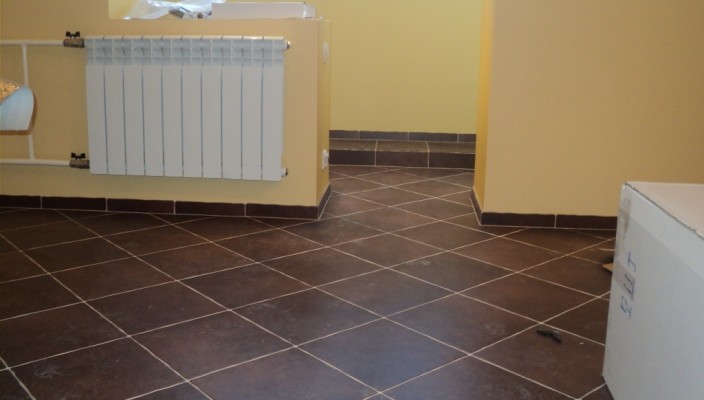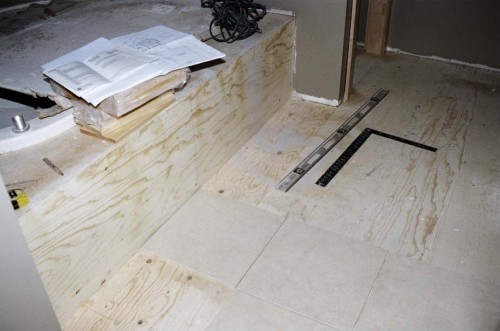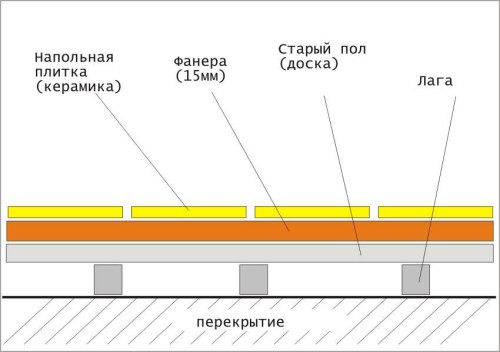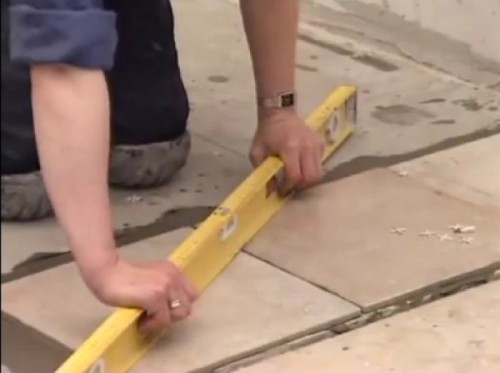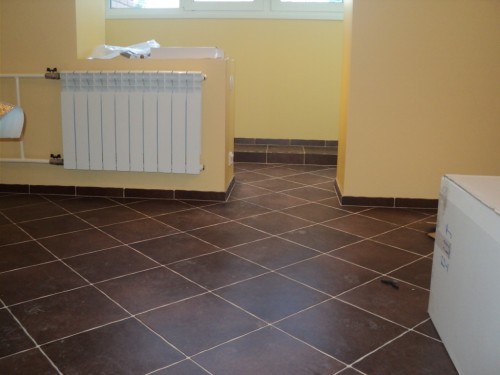Often for facing the tile of the base of the black floor make the sheets of plywood. This is due to the fact that this material allows for quite a short time to eliminate and level the existing surface defects. Before laying down a tile on Faneru, you need to know some of the features of this process. Tell me further.
Content
Basic moments
Some do not want to use Phaneur as the basis for masonry tile, because they believe that this material is not very durable. Therefore, choose a concrete tie. In fact, if you do everything correctly, I should not have problems with plywood. In addition, this material is easier to fit than the screed. In particular, time to carry out installation work is required much less. In addition, Phaneur does not need to pre-prepare, and this significantly reduces the total cost of laying.
However, when this material is selected, some important rules must be taken into account, on which the quality of work on laying tiles on the phaneer depends on. For example, only moisture-resistant faeer should be used as a base under the tile. To attach this material to the surface there is a glue or self-tapping screw. The plywood sheets are stacked in such a way that a small groove of 3 mm wide remains between adjacent parts.
When the plywood is selected, it is important to know from which its price is. Some of the main factors affecting the cost is considered the material of the material and the limit dimensions of the sheet. If you do not want to acquire expensive materials, you can choose a second-grade fane. The cheaper option will be a combined plywood 2/3 of the variety. Material sheets 3 varieties are also inexpensive.
How to choose glue for tile on Fane
We will analyze such an important question as the choice of composition for the solution. This will understand, the better to stick the tile to the plywood basis. In general, for any similar material, you can choose a suitable type of solution or buy a universal version designed for wood. The glue with such a composition is rather liquid, so that the mixture itself is distributed over the surface. Therefore, after installation, there is no need to tap the tile with the help of a queen. But you can not only glue the ceramic tile on Faneur.
Less nails, liquid glass or nitrocellulose varnishes are used less often for stacking tiles. These methods are not able to give a complete guarantee of the quality of the attachment. For this reason, it is desirable to choose all the same special mixtures.
If you choose the glue to which you will be glued, you should know which of them are suitable for this purpose, and which are not. So, for example, the glue for a concrete base is not recommended. It has the flexibility that can lead to wood movement, and this will move the tile further than what is required.
In order for the tile to securely glue the plywood sheets, two-component solutions or silicone-based compositions are used. For the same purpose, it is less likely to use special blocks for moving grounds. All these funds provide good adhesion and additional protection against moisture, which is very important for the floor.
In addition to glue, some auxiliary materials will be needed.
Preparatory work
From tools for performing work, you will need a rubber spatula and carbon black chain. We will also need a toothatel and construction level. Materials will need tiles, sealant and plastic crosses. In addition, self-tapping screws, glue, and primer will be required.
It should be said that the tile can not be glued to the finalen base. Therefore, some actions are required to improve the adhesion. For this, Phaneur is first treated with an antiseptic and a mixture to protect against moisture. This needs to be done, even if moisture-resistant sheets are used. Next, with the aim of improving adhesion on the surface of the plywood sheets, the sulfage grid is fixed. In addition, the material should be covered with several layers of primer. This will improve adhesion and additional waterproofing will improve.
How to put a tile on Faneru: Basic Requirements
Consider in more detail how to perform the laying of PVC tiles on the fane.
Primary requirements:
- If there is wooden floors in the room where work is carried out, then you need to use antiseptics. Their use is necessary. They allow you to prevent the appearance of mold and fungi in the future. In addition, these tools will be removed from the occurrence of harmful insects under the laid floor.
- Before applying the glue composition for laying tiles on Faneru, it is recommended to learn more about its composition. Perhaps there is a hardener. Then work on laying should be carried out quite quickly. The fact is that glue with the hardener quickly solidifies.
- There are also certain requirements for the thickness of the plywood stacked. It should be about 25 mm. This is enough to get a reliable basis.
- We still have no need to forget that even moisture-proof plywood over time is able to deform under the action of moisture. Therefore, it is desirable to use additional waterproofing means.
- Many are wondering where to start laying tiles. The most optimal way is the start from the second row from the far wall. In any of the options for glue on the working surface when applied, it is necessary to mold.
How to stick a tile on the fane
Consider stages, how to glue a tile on Faneru:
- When everything you need is available in stock, you can start on the installation, and it should be started with preparation. It implies the purification of the surface from dust and dirt. But if the floor is played, you will first need to remove the old finish coating.
- Inspect the surface, it should not be defects, for example, chips, cracks. Available between floor and wall joints need to be sealed using cement. Plywood sheets themselves must first be degreased and cleaned. Only then on the surface can be applied adhesive solution.
- Before you to store PVC tiles on Faneru, you need to align the base and cover it with the primer.
- The process of laying is recommended from the center of the room. And the first thing to do is to perform, the so-called, "dry" laying. In this case, the facing material is laid out so that only the walls need to use cropped pieces. If it is necessary, the line is allowed to move a bit so that the result of the work performed was a neat and even drawing.
- When it is done, the tile can be carefully fixed on glue. After the laid material with a slight force rolling the roller. Due to this, the remaining air will be released from under the tile.
- Glue apply to a plywood sheet with a spatula on a plot of no more than 1 sq.m. Moreover, glue will have enough quickly, because The composition will instantly dry. Tool evenly distribute glue on plywood base.
- When the first tile is laid on the pellery covered with glue, it should be slightly pressing and checking the horizontality through the construction level. If you detect some defects (potholes, height drops), let's knock on the surface with rubber xy to dissolve it.
- Then again check the horizontal wall level. After that, we proceed to sticking the second tile. The joints between the material should be noted by special plastic crosses installed in the corners. They will help adjust the suture size in width.
- Next, two more tiles are laid out. This pair should be aligned by the first two. Similarly, the entire work surface is facing. The cutting tile near the walls should be put only after the rest dries. The glue for the plywood base is good because it will dry fast enough. Therefore, by almost the finite sex, it will be possible to walk in a few hours. By the way, during the laying it follows as quickly as possible to remove the protruding glue from the surface. It must be done so that it does not leave dark spots.
- When laying a tile can start sliding down. So that this does not happen, at the bottom at the level of the second row would be good to kill a wooden rail. It is important that it is strong enough to withstand the design until it does not dry.
- After that, the rail is removed, and the remaining chopped pieces of tiles along the edges are stacked.
- Tile on the paneur to the floor can be laid, starting from the second row from the wall. Allowed options are the installation towards the center of the room and diagonally. In general, the laying method is chosen primarily based on the size of the room itself, as well as depending on the desired drawings and some other important factors.
- After laying the sheet to the working surface, knock on it with Cyans. In addition, slightly move it to the sides. It is necessary in order for glue as it should be grabbed.
- Next, there are several holes under the dowel and self-tapping screws on the sheet of plywood. After laying the plywood sheets in place, they need to carefully clean from dust and polish. Then at least two layers of primer are applied to them.
- The glue itself is preparing several times, but in small portions. This is done so that he does not have time to dry during work. For an hour it is desirable to cover about 1 sq.m. Surfaces.
- It should be remembered about the need to periodically check with the help of the construction level the horizontal of the laid tile. After all, after working on the installation of tiles on the plywood will be completed, the floor will no longer work.
- Next you need to wait for a couple of days until the glue dries. Only after that you can continue to work.
- When the floor is finally driving, the seams need to be processed. First of all, the previously installed crosses are removed.
- After that, the seams are processed by grouting. It is applied using a rubber spatula. In this case, the tool should be directed relative to the seams perpendicularly. Due to the qualitatively completed grout, you can protect the lined surface from accumulating and moisture. This will prolong the service life of the tile and will affect how hard it will hold.
- When all the joints are pretty shovels, you should give them time to dry. Then the tile must be cleaned and washed from the residues of building mixtures. To do this, a piece of a rag of soft light fabric is suitable. At the same time, it is important not to wash out of the seams recently inflicted grout. It remains to graze with the help of a sponge or dry fabric.
Similarly, laying the tiles on the phaneer under the warm floor.

